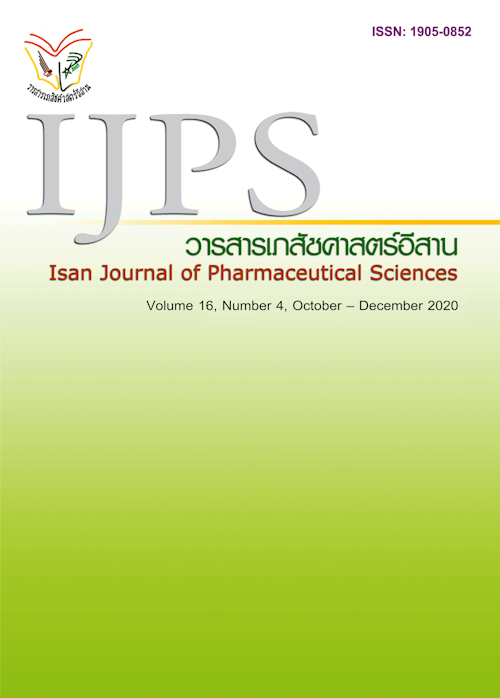The Determination of Doxycycline Using Ferrous Sulfate Contained in Vitamin Tablets as Reagent
Main Article Content
Abstract
A simple spectrophotometric procedure for determining doxycycline is proposed. It is based on the reaction between this drug and ferrous sulfate from vitamin tablets in acidic solution. The presence of hydrogen peroxide enhances the absorption signal. Methods: The proposed method was applied successfully to analyze doxycycline in pharmaceutical dosage forms. The highest absorption was measured at 425 nm after mixing the solutions. Either standard or sample solution was mixed with 5.0 x 10-2 mol/L of ferrous sulfate from vitamin tablets in 5.0 x 10-3 mol/L of nitric acid and 2.5 x 10-2 % (v/v) of hydrogen peroxide in a ratio of 2.0 : 1.0 : 0.1 (v/v), respectively. The optimum conditions for determining doxycycline were investigated by the univariate method. Results: Using the proposed procedure under optimum conditions, linear calibration graphs were obtained for doxycycline concentrations from 1.0 to 50 µg/mL. Linear regression analysis of the absorbance of drug (y) versus drug concentration (x) yielded the equation y = 0.0042x + 0.0017. The correlation coefficient was 0.9994. The detection limit of doxycycline, the concentration of analyte that gave a signal different from the blank by an amount equal to three times the standard deviation of the blank signal (s/n=3), was found to be 0.3 µg/mL. The quantitation limit (defined as ten times the standard deviation of the blank signal) was 0.9 µg/mL. Moreover, the common excipients used as additives in the pharmaceutical dosage forms showed no effect on the proposed method. The results acquired by the proposed method compared favorably with those acquired by the reference method at a 95% confidence level with no significant difference (n=7). Conclusion: The proposed spectrophotometric method is a simple method for analysis of doxycycline with many advantages such as simple reagents, high accuracy, high reproducibility, and is therefore a rapid and acceptable alternative method for the routine quality control of doxycycline in drug formulations.
Article Details
In the case that some parts are used by others The author must Confirm that obtaining permission to use some of the original authors. And must attach evidence That the permission has been included
References
Anastas P, Eghbali N. Green chemistry: Principle and practice. Chem. Soc. Rev. 2010; 39: 301-312.
Bryan PD and Stewart JT. Chromatographic analysis of selected tetracyclines from dosage forms and bulk drug substance using polymeric columns with acidic mobile phases. J Pharm Biomed Anal. 1994; 12:675-692.
Cambell NRC and Hasinoff BB. Iron supplements: a common cause of drug interactions. Br J Clin Pharmacol. 1991; 31: 251-255.
Choma I and Pilorz K. A novel application o matrix solid-phase dispersion for determination of doxycycline and flumequine residues in milk. J. Liq. Chromatogr. Relat. Technol. 2004; 27: 2143-2151.
Ding X and Mou S. Iron chromatographic analysis of tetracyclines using polymeric column and acidic eluent. J Chromatogr A. 2000; 897: 205-214.
ICH Expert Working Group. ICH harmonized tripartite guideline: Validation of analytical procedures: Text and methodology Q2 (R1). 2005.
Izquierdo P, Gomez-Hens A and Perez-Bendito D. Simultaneous stopped-flow determination of tetracycline and doxycycline in serum based on lanthanide-sensitized luminescence. Anal.Lett.1994; 27(12): 2303-2316.
Kruanetr S, Liawruangrath S and Youngvises N. A simple and green analytical method for determination of iron based on micro flow analysis. Talanta 2007; 73: 46-53.
Mohamed HM. Green, environment-friendly, analytical tools give insights in pharmaceuticals and cosmetics analysis. Trends Anal. Chem. 2015; 66: 176-192.
Naidong W, Geelen S, Roets E and Hoogmartens J. Assay and purity control of oxytetracycline and doxycycline by thin-layer chromatography-a comparison with liquid chromatography. J Pharm Biomed Anal. 1990; 8: 891-898.
Palamy S and Ruengsitagoon W. A novel flow injection spectrophotometric method using plant extracts as green reagent for the determination of doxycycline. Spectrochim. Acta Part A Mol. Biomol. Specrosc., 2017; 171: 200-206.
Ramesh PJ, Basavaiah R, Divya MR, Rajendraprasad N, Vinay KB and Revanasiddappa HD. Simple UV and visible spectrophotometric methods for the determination of doxycycline hyclate in pharmaceuticals. Anal Sci. 2011; 66: 482-489.
Salinas F, Munoz de la pena A and Duran Meras I. Analysis of mixtures of doxycycline and oxytetracycline in pharmaceutical preparations by first derivative fluorimetry. Anal.Lett.1990; 23(5): 863-876.
Sunaric SM, Mitic SS, Miletic GZ, Pavlovic AN and Naskovic-Djokic D. Determination of doxycycline in pharmaceutical based on its degradation by Cu(II)/H2O2 reagent in aqueous solution. J. of Anal. Chem. 2009; 64(3): 231-237.
Sweetman SC. Complete drug reference. 36th ed. China: Everbest Printing; 2009.
The United States Pharmacopoeia, USP 31 NF26, pp 2023-2025. 2008.
Vilayphone S and Ruengsitagoon W. Simple spectrophotometric method for determination of iron (III) content. Isan J. Pharm Sci. 2018;14(2): 113-121.
Xie HZ, Dong C, Fen Y and Liu CS. Determination of doxycycline, tetracycline and oxytetracycline simultaneously by TLC-Fluorescence scanning densitometry. Anal.Lett. 1997; 30(1): 79-90.


